#preserver l ecosysteme
Explore tagged Tumblr posts
Text
Des sujets captivants à découvrir dans des vidéos à télécharger
Vous constaterez l’implication profonde de Buzz No Limit envers ses membres à travers sa couverture étendue de sujets captivants et pertinents qui retiennent l’attention dans l’actualité internationale. Qu’il s’agisse de faits divers brûlants, de divertissements attrayants, de sujets culturels ou d’autres domaines, Buzz No Limit s’efforce de répondre aux attentes variées de ses utilisateurs. Pour…

View On WordPress
0 notes
Text
Like you can't be all for Landback in Turtle Island and then somehow think zionism & the state of Isntreal is a "landback movement" where some of the tenants are that 1. Landback doesn't mean creating an ethnostate (which Isra*l has been trying to do & this was the goal of the State from the beginning) 2. Landback does not mean or require or encourage Kicking everybody else out (which Isntreal is trying to do with the Palestinians and has been doing since 1948 and its government has been saying they explicitly want to do) 3. Landback does not encourage or require "Reverse colonizing" or committing genocide against the settler or any immigrant population (which Isntreal has repeatedly done, is doing, and wants to continue to do, so even if you think that Israelis are "Indigenous" and that the Palestinians or "Arabs" weren't, this is still going directly what Landback is explicitly against) 4. Reintroducing Native plants & wildlife to the area to undo effects of colonization in the ecosystem (& Isntreal has been planting invasive plants to the Levant, colonization has killed off Native species such as the Palestinian crocodile, and made it illegal for Palestinians to forage culturally important plants like Za'atar, the uprooting of Olive trees, or collect RAINWATER under the premise of "ecological preservation" in the same way that National Parks were created specifically to disenfranchise Native Americans under the guise of "ecological preservation", not to mention the terrorizing of Palestinians with bombs & has been polluting the area)
You have to be a special type of stupid & brainwashed if you think the latter is "Landback" when the State is literally doing everything that the Landback movement has specifically said its against
630 notes
·
View notes
Text
Fossil Novembirb 10: Bayou in the Badlands

Fluvioviridavis by @quetzalpali-art
Back to Eocene Ecosystems! One of the most famous Eocene fossil sites in the world is the Fossil Lake site of the Green River Formation, an ecosystem from Colorado in the United States. This ecosystem records the transition from the moist forested world of the early Eocene to the drier warm world of the mid-Eocene. The forests would begin to shrink back, the foliage would change, and so would the animals.
Fossil Lake records the start of that process! Sediment would regularly settle into this lake at periodic intervals, which then recorded the evolution of the lifeforms there over thousands of years. The forests were filled with sycamore trees and other broadleaf plants, as well as ferns.

Limnofregata by @iguanodont
Because the lake was so frequently filled with sediment, oxygen levels were low to nonexistent, preventing decomposers from living at the bottom of the lake. This lead to many different organisms being preserved nearly perfectly, including many gorgeous birds!
In fact, the Field Museum of Chicago - my home - has many of these wonderful fossils on display, and have fascinated me since childhood. So I'm going to break format a little here to showcase some of these fossils.

Cyrilavis, a Halcyornithid (Parrot-Passerine of Prey)
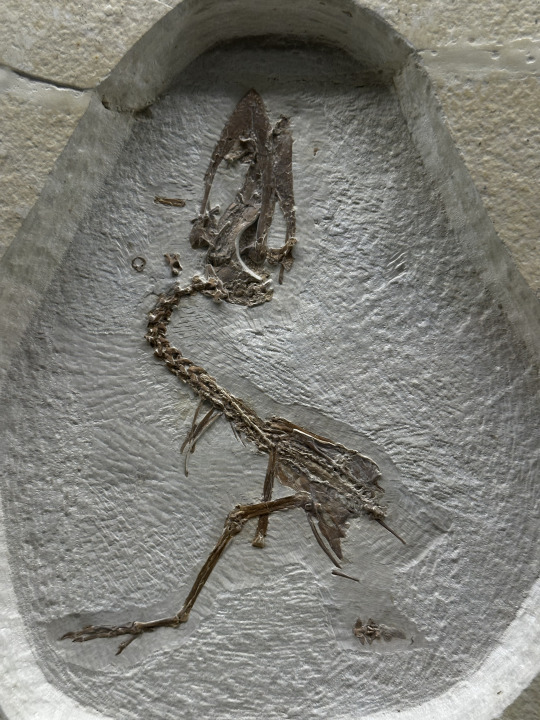
Fluvioviridavis, a Strisorian (like oilbirds or frogmouths)
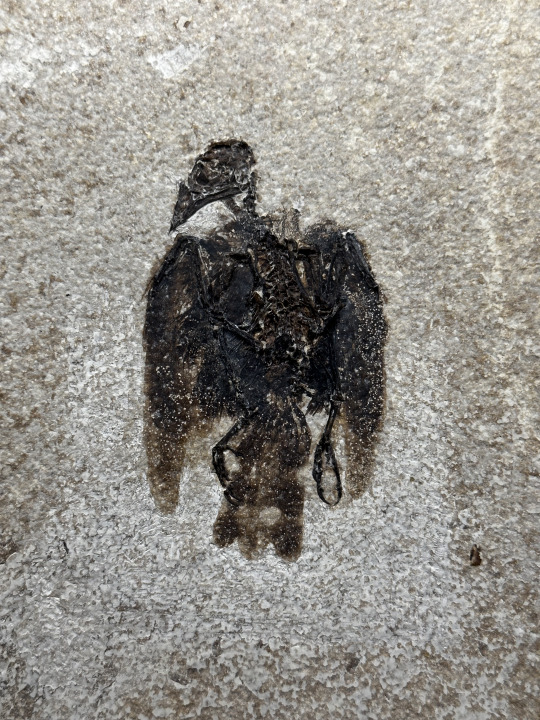
Eofringillirostrum, a Passerine

Limnofregata, a Frigatebird in a Gull Niche

Nahmavis, a relative of shorebirds (Charadriiformes) or rails and cranes (Gruiformes)
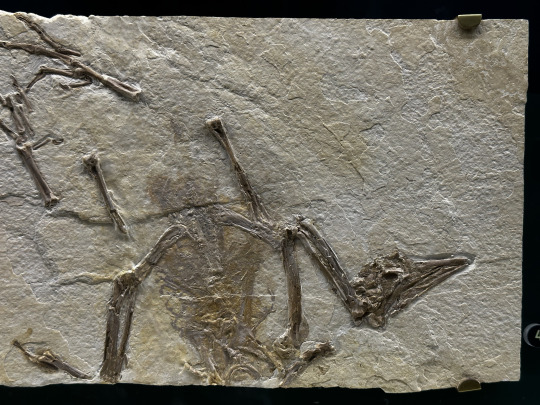
An unnamed Anseriform, probably similar to Anachronornis

Celericolius, a mousebird

Zygodactylus, a stem-passerine
We see once again in this ecosystem - as we have in the others we've covered - the common theme of Avian evolution: the niches may stay the same, but the birds filling them will always change. We have Mousebirds perching in trees in North America, we have Frigatebirds filling the Gull niche, ducks wading around the lake like flamingos, and cousins of parrots/passerines hunting prey.
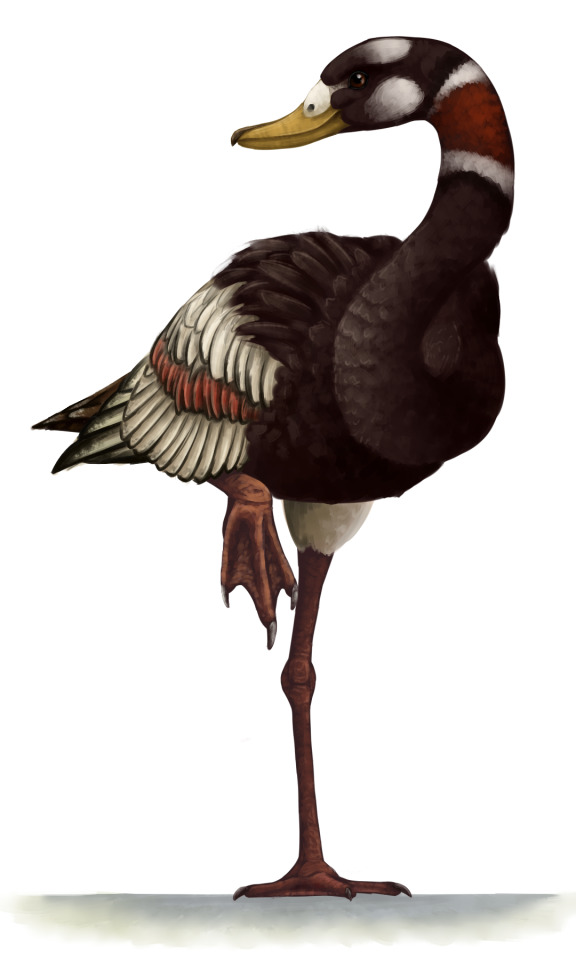
Presbyornis by @drawingwithdinosaurs
Other notable dinosaurs from this formation include Presbyornis, another one of those Flamingo-Ducks we've talked about like Teviornis and Conflicto; Gastornis because it was literally everywhere from the latest Paleocene through the early Eocene; Lithornithids like Pseudocrypturus because they were also everywhere; early landfowl like Gallinuloides; the cuckoo-roller Plesiocathartes; the ibis Vadaravis; and the turaco relative Foro. Once again, we see many tropical birds in places where they aren't today, due to the extensive warm climate of the Early Eocene.
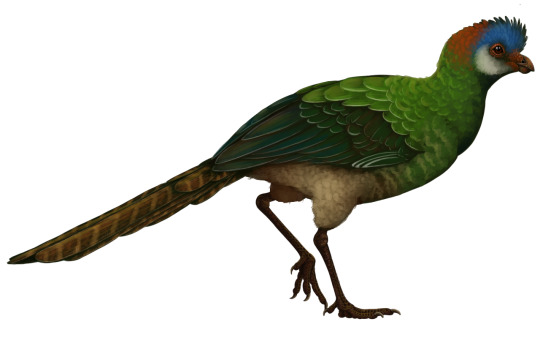
Foro by @drawingwithdinosaurs
This swampy ecosystem was filled with large crocodile relatives, small mammals, the earliest known bats, giant lizards, and an alarming number of fish - making it one of the better known ecosystems of the early Paleogene. But the best known Paleogene fossil location is still to come...
Sources:
Grande, L. 2013. The Lost World of Fossil Lake: Snapshots from Deep Time. University of Chicago Press.
Mayr, 2022. Paleogene Fossil Birds, 2nd Edition. Springer Cham.
Mayr, 2017. Avian Evolution: The Fossil Record of Birds and its Paleobiological Significance (TOPA Topics in Paleobiology). Wiley Blackwell.
103 notes
·
View notes
Text
Day 49 of posting cute creatures we found on our field trip:

Liparus glabrirostris is the largest beetle of the Curculionidae family native to Europe. It has a shiny black body covered in small pale yellow spots. Its “paws” are super sticky so that it can hang on giant leaves of Petasites hybridus plant. Those leaves can be over 1 meter wide and have a smooth surface that prevents water from forming puddles in them. The forests covered in these plants looks surreal:


The L. glabrirostris beetle feeds on this plant’s sap. These images were taken in Biogradska gora national park in Montenegro. The park is very small, but it shows an actual ancient forest untouched by humans, encircling a mountainous lake with many many streams running through it. Most trees here are over a century old and ecosystems are almost perfectly preserved.
21 notes
·
View notes
Text
thinking about Frieren and Dungeon Meshi today and just remembered seeing a post/comment or two saying that people have no reason to compare the two stories since they have nothing in common except being non-isekai fantasy. different tones, different pacing, different themes, etc.
i don't know if whoever said that were dunmesh manga readers or not, but i kinda assume they were making judgments based purely on however much of the anime was released at the time, because i think about how similar these stories are a LOT, actually.
[spoilers for the dungeon meshi manga below, and a little bit of frieren manga]
i think that's a pretty fair assessment to make based JUST on the "prologue"/setup arc leading up to the red dragon. while some of the main themes are very in-your-face, others are still being woven into the characters and established much more subtly, and we don't get the full weight and payoff for that early work until later into the story.
Frieren establishes its identity within the first episodes and never drastically deviates from that first impression. on the other hand, dunmesh takes its time to build its foundation...but instead of using it as groundwork to build a house above, it then leads you into the depths of the dungeon below.
the stuff about conflicts between long-lived and short-lived races seem like just jokes/banter and a touch of political worldbuilding, in the beginning, but that tension is absolutely central to both Marcille and Kabru's arcs. both Frieren and dunmesh are about elves facing their (near) immortality in contrast with the brief mortality of their companions.
I think about the ways Frieren, with a thousand years of life behind her, carries the memories of those she's outlived along with her and all the ways she emulates them to preserve their lives and values. I think about the way Marcille, with a thousand years of life ahead of her, clings so tightly to the people she holds dear and fears the future she sees beyond their deaths.
I think about the way Serie talks about training Flamme on a whim, casually dismissive of short human lifespans. I think of the way Kabru resents the way elves treat short-lived species like children and fights so desperately for their agency and right to speak on the same level as the rest, fully informed of the dangers that threaten them all instead of being left in the dark.
beyond that, too--you can really feel that these series come from a place of love for the genres that inspired them. dunmeshi's speculative biology for the monsters and the ecosystem they're a part of, the exploration of how and why different races get different "stat" bonuses (dwarven constitution, half-foot perception, tall-man versatility, elven/gnomish magical affinity), the side comic about "Grease" as a starter spell--all obviously come from deep knowledge and affection for D&D and/or similar rpgs.
meanwhile, Himmel gives thoughtful weight to doing "side quests" for paltry rewards--they help because they're heroes, but they accept scraps and useless items for rewards because no one wants to feel pitied or indebted to anyone. he says they "went the wrong way" if they find the stairs to the next floor in a dungeon, because the "right" way is to explore every nook and cranny first before you progress. it would be very easy to mock how annoying fetch quests are, or make the dungeon bit a pure joke--but this is a story that relishes the process and the journey of it all, down to the smallest detail and silliest quest.
flashbacks to Falin being achingly kind and gentle, and also strange and awkward. flashbacks to Himmel being blindingly heroic and noble, and also vain and goofy.
these are both stories about the weight of death and loss and the things we'll do to see our loved ones one last time, when we are destined and doomed to outlive them. they're about the joy of the journey even when it's painful, thriving on silliness even when things are "serious," and loving the people in your life knowing you will lose them, and how you carry them with you when they're gone. dunmeshi is heavier on the comedy side of things, but both have their fair share of emotional gutpunches, and their themes and values mirror each other.
all this to say, these stories are holding hands.
#dungeon meshi#dungeon meshi spoilers#frieren#delicious in dungeon spoilers#dm manga spoilers#frieren spoilers#frieren manga spoilers#i don't think i talked about anything in frieren that hasn't already been in the show...#nevermind i checked the side quest reward thing hasn't been animated yet#there are of course differences but the similarities are way more than just 'non-isekai fantasy'#this is also inspired by a post saying that Marcille and Frieren are just on opposite ends of their lifespans bc i think about that a lot#also: ik frieren is over 1000 years old. more poetic for the parallel to fudge the detail
40 notes
·
View notes
Text
History and Interpretation (BLOG 6)
Hello and welcome back to my nature blog! This week I have done some thinking on history and how things of the past can be interpreted. When we think of history, we think of the great stories and background behind artifacts that are left over. However, without interpretation, these artifacts that unpack tales of the past would simply be items or really old landscapes. In nature, history allows the information about land, the species it holds, and the people that use it to be conveyed and be used in many ways. History in nature allows local communities to share their past, gives cultural richness, and helps scientific research study the land for important preservation or monitoring rising issues like climate change.
"There is no peculiar merit in ancient things, but there is merit in integrity, and integrity entails the keeping together of the parts of any whole, and if these parts are scattered throughout time, then the maintenance of integrity entails a knowledge, a memory, of ancient things. …. To think, feel or act as though the past is done with, is equivalent to believing that a railway station through which our train has just passed, only existed for as long as our train was in it."
(Edward Hyams, Chapter 7, The Gifts of Interpretation)
In this quote shared as this week's prompt, it seems Edward Hyams dives into the meaning of interpretation in the context of preserving history. He starts by introducing the merit of artifacts, in which he describes what I had mentioned: without a story and someone to debunk the history and an honest background, historical artifacts have little to no worth. The mention of ancient things acknowledges the importance of remembering the history of a place or artifact and how they contribute to the present. This is extremely applicable when talking about nature's history as historical landscapes and ecosystems are all formed by their long evolution over time. These evolutionary processes are important to be understood through interpretation to debunk how species, the climate, and the earth came to be. The last part of the quote uses a train station analogy to describe the importance of memory. This analogy describes that the past isn't simply something to be discarded or ignored. Just because an event is past, doesn't mean that it wasn't significant to the present or future. I think Hyams quote also can describe how disregarding historical events that “only existed for as long as our train was in it”, creates struggle in using natural history for conservation. The historical aspects of nature continue to influence the future and we can't forget about the past as there may be great clues to drivers of change currently in ecosystems. For example, cycles of lower temperatures like the ice ages and warmer interglacial periods are all elements of environmental history that have allowed scientists to study the earth's climate and predict the natural waves of temperature versus human impact. Interpretation also keeps historical culture alive and teaches younger generations about having a relationship with nature. An example of this is how Indigenous communities keep their ancestors' history alive for cultural reasons and use stories to convey the importance of certain natural features or landscapes for spirituality (Beck et al., 2018, p.341).
It is extremely important to remember history. This makes interpreters especially important as their role is to keep the integrity of history alive and not forgotten (Beck et al., 2018, p.326). With this, preserving history can be a driver of change for the future having a huge impact on scientific research and cultural practice. Without acknowledging and remembering the past, these "trains" of history will be lost.
Resources
Beck, L., Cable, T. T., & Knudson, D. M. (2018). Interpreting Cultural and Natural Heritage: For a Better World (pp. 81–102). Sagamore Publishing LLC. https://sagamore.vitalsource.com/books/9781571678669
10 notes
·
View notes
Text
NATURE & SHIPWRECKS (unit #5 - freestyle)
Hello friends,
We are back again this week with the most exciting prompt yet: no prompt! I am taking this opportunity to talk about my biggest childhood interest… SHIPWRECKS!
You might be wondering how this relates to nature at all but deep-sea shipwrecks are biodiversity hubs. I have always been interested in shipwrecks because I am both terrified and in awe of them. My main fascination is with how such an inorganic and visually man-made object is completely emersed by aquatic life and fits so well in an ecosystem it was never intended to be in.
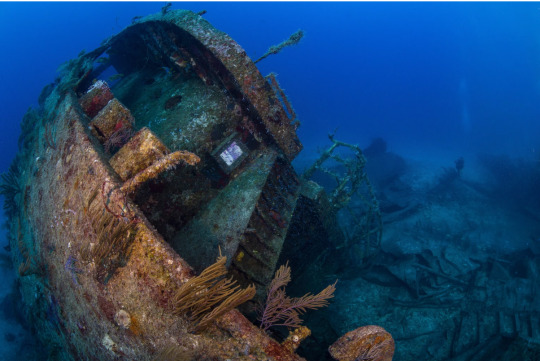
STOCKTREK IMAGES. (n.d.). A sunken ship lays on its side near Grand Bahama Island, Bahamas. How do we find shipwrecks—and who owns them? National Geographic. Retrieved from https://www.nationalgeographic.com/history/article/how-do-we-find-shipwrecks-and-who-owns-them.
Shipwrecks are considered “islands of biodiversity” because they offer a structure for an incredibly wide variety of species to inhabit, which creates pockets of very high biodiversity, acting as artificial reefs (Hamdan et al., 2021). Imagine a sandy sea floor with not much going on besides some small rocks and vegetation, now put a huge stationary shipwreck there, and eventually, many species will call this new isolated habitat their new home. Many shipwrecks are dripping with so many species that you cannot even see bare metal anymore.
It is clear from photos that there are lots of different fish, vegetation, and corals that inhabit old shipwrecks, but we are missing a very important aspect of shipwreck ecosystems: the micro-organism colonies! In our defense, we can't see them but they make up a huge portion of biodiversity. Microorganisms establish and preserve shipwrecks as artificial reefs, allowing other species to thrive in/on shipwrecks. It is amazing how much power the tiny species hold and how influential they are to full ecosystems. (Hamdan et al., 2021)

Murat. (n.d.). Bream Fish around the shipwreck. How do we find shipwrecks—and who owns them? Adobe Stock Images. Retrieved from https://www.bristolaquarium.co.uk/animal-stories/animals-that-find-a-home-in-sunken-ships/
I have never had the opportunity to visit a shipwreck other than kayaking over top of a boiler. I love watching videos of people diving to explore shipwrecks, although I can't imagine ever doing it myself. I am incredibly curious to hear if anyone has done this? I would absolutely love to hear your experiences! We (Ontario locals) live in the perfect place to go shipwreck diving because the Great Lakes have cold water and low salinity which are fanatics conditions for the preservation of shipwrecks. The Great Lakes are regarded as one of the best shipwreck diving spots in the world. (Harrington, 2019)
I have always found shipwrecks interesting because of the duality that the vessel wasn't strong enough to complete its voyage but it is strong enough to be preserved underwater for (possibly) hundreds of years, sometimes in near-perfect condition. However, the shipwrecks of the Great Lakes are in trouble!! Invasive species of the Great Lakes like zebra mussels (Dreissena polymorpha) and quagga mussels (Dreissena rostriformis bugensis) are threatening our beautifully preserved nuggets of history. These filter feeders can cause damage through heavy weight and even corrosion of some metals, if enough pile up. Additionally, they release carbon dioxide which can severely alter water quality and the conditions that help preserve shipwrecks. It is insane that these huge structures that can last up to thousands of years can be threatened by something as small and seemingly passive as mussels. (Harrington, 2019)
Thanks for reading, hopefully you see shipwrecks from a slightly different perspective! Who knew shipwrecks were so intertwined with nature (I did because I am a nerd who loves shipwrecks)!
References
Hamdan, L. J., Hampel, J. J., Moseley, R. D., Mugge, R. L., Ray, A., Salerno, J. L., & Damour, M. (2021, April 22). Deep-sea shipwrecks represent island-like ecosystems for marine microbiomes. OUP Academic. https://doi.org/10.1038/s41396-021-00978-y
Harrington, M. (2019, November 20). Aquatic invasive species threaten shipwreck preservation in the Great Lakes: Wisconsin sea grant. Wisconsin Sea Grant | University of Wisconsin. https://www.seagrant.wisc.edu/blog/aquatic-invasive-species-threaten-shipwreck-preservation-in-the-great-lakes/
18 notes
·
View notes
Text
Unit 09: The Wonderful World of Bees
Growing up, I was lucky to witness the fascinating world of bees firsthand. My grandmother kept bees in Portugal, and watching her work with them sparked my interest in these remarkable creatures. I would accompany her and my father as they tended to the hives, I observed them sedating the bees and extracting honey from a safe distance. From my experience in the apiary I learned that bees are not just simple insects. Bees are key players in ecosystems, with complex behaviours and abilities that make them integral to our planet's health.

My family’s honey, freshly packaged and ready for sale at the town market.
The highly organized social structure of honeybees is fascinating. In the hive, every bee has a role. Worker bees gather pollen and nectar, drones mate with the queen, and the queen herself lays up to 2,000 eggs daily, maintaining the hive's population (Rutter, 2022). One of the most captivating aspects of bee life is their "waggle dance," a form of communication that honeybees use to share the location of flowers with nectar (von Frisch, 1974). Through this dance, they convey distance, direction, and even the quality of food sources, helping the entire colony forage efficiently. Watching a bee dance is like witnessing nature's GPS in action.
youtube
A video showcasing the fascinating "waggle dance" of bees.
Bees contribute far beyond just honey production. About 75% of the world's flowering plants depend on animal pollinators, with bees playing a leading role (Klein et al., 2007). They pollinate approximately 35% of the global food supply, including countless fruits, vegetables, and nuts, all of which would diminish without their pollination. Through their pollination efforts, bees maintain the diversity of plants, supporting various wildlife species. The entire food chain benefits from bees' activity.
A unique trait of bees is their ability to see ultraviolet light. Flowers have evolved to display ultraviolet patterns invisible to the human eye that guide bees directly to nectar sources (Chittka & Menzel, 1992). This incredible vision enhances the bees' efficiency as pollinators, allowing them to gather resources quickly. Their buzzing sound isn't just noise, It's often used in "buzz pollination," a technique to shake loose tightly packed pollen, ensuring maximum collection (Buchmann, 1983). This adaptive method illustrates their evolution as expert pollinators.

A rose flower illuminated under ultraviolet light, revealing intricate patterns that guide bees to its nectar.
Climate change presents significant threats to the survival of bees. Elevated temperatures, shifting precipitation patterns, and more frequent extreme weather events disrupt bees' foraging activities, nesting sites, and reproductive cycles. Some bee species have responded by relocating to cooler regions or altering their activity periods to adapt to these changes. This decline threatens the bees and the ecosystems and agricultural systems that depend on their pollination services. Therefore, it is imperative that we implement conservation strategies that support bee populations. These include preserving and restoring natural habitats, promoting agricultural practices that are friendly to pollinators, and reducing the use of harmful pesticides. By taking these actions, we can help ensure that bees continue to thrive and perform their vital roles in our ecosystems.
References
Buchmann, S. L. (2019). Buzz Pollination in Angiosperms. DigitalCommons@USU. https://digitalcommons.usu.edu/bee_lab_bo/266/
Chittka, L., & Menzel, R. (1992). The evolutionary adaptation of flower colours and the insect pollinators’ colour vision. Journal of Comparative Physiology A, 171(2). https://doi.org/10.1007/bf00188925
Honey. (2017, October 16). Honey bee waggle dancing. YouTube. https://youtu.be/1MX2WN-7Xzc
Klein, A.-M., Vaissière, B. E., Cane, J. H., Steffan-Dewenter, I., Cunningham, S. A., Kremen, C., & Tscharntke, T. (2007). Importance of pollinators in changing landscapes for world crops. Proceedings of the Royal Society B: Biological Sciences, 274(1608), 303–313. https://doi.org/10.1098/rspb.2006.3721
Night Blooms: A Collection of Ultra-Ultraviolet Botanical Portraits. (2023). Rain Hayes Photography. https://www.rainhayes.com/gallery/night-blooms-uv-flower-blog/
Rutter, B. (2022, May 19). 3 Levels of Bee Hierarchy: Drone Bee, Worker Bee, and Queen Bee. Bestbees.com. https://bestbees.com/2022/05/19/bee-hierarchy/
3 notes
·
View notes
Text
Embracing Nature's Diversity: Exploring Its Most Incredible Phenomenon
In a world often consumed by the rush of daily life, it is easy to overlook nature's breathtaking diversity. Today, I will shine a spotlight on what I believe to be the most remarkable phenomenon in the natural world: its unparalleled diversity. Join me on a journey as we celebrate the astonishing variety of life on Earth and discover how each of us can forge a deep connection with its wonders.
Nature's diversity is nothing short of incredible and inspiring. From the majestic redwoods of California, reaching skyward and touching the clouds, to the vibrant coral reefs of the Great Barrier Reef, pulsating with life beneath the waters, our planet is home to millions of extraordinary ecosystems, each a masterpiece in its own right. This rich abundance of biodiversity paints a vivid portrait of nature's ingenuity and resilience, captivating our imagination and inviting us to explore its boundless wonders.


Here are some photos from a weekend getaway in Niagara Falls, ON. Look at the diverse array of colours!
There is something for everyone to connect with within this vast assortment of life. Whether it is the graceful flight of a hummingbird or the gentle sway of a towering palm tree, nature speaks to each of us in its unique language. Nature's boundless diversity ensures that there is something for everyone, regardless of age, expertise, or background, inviting all citizens to explore, learn, and connect with its wonders (Beck et al., 2018). In these moments of connection, we find comfort, wonder, and a profound sense of belonging in the world around us.
So, how can we nurture this connection with nature? It begins with simply taking the time to pause, observe, and appreciate the world around us. Whether embarking on a hike through a lush forest or simply marvelling at the intricacies of a single flower, there are countless opportunities to immerse ourselves in nature. By doing so, we enrich our lives and deepen our appreciation for the beauty and complexity of the natural world (Beck et al., 2018).
Moreover, embracing nature's diversity is not just about personal enrichment but also about recognizing our role as stewards of the planet. As we witness the devastating impacts of climate change and habitat destruction, it is more important than ever to take action to protect and preserve our precious natural spaces. Whether supporting conservation initiatives, advocating for environmental policies, or simply making sustainable choices in our daily lives, we have the power to make a difference.
In essence, nature's diversity is its most incredible phenomenon, offering us a window into the richness and complexity of life on Earth. By honouring its magnificence and embracing our connection to it, we not only enrich our own lives but also contribute to the collective well-being of our planet. Let us step outside with open hearts and eager spirits, embarking on a journey of discovery and appreciation amidst the captivating beauty of nature's diverse wonders.
Beck, L., Cable, T. T., & Knudson, D. M. (2018). Interpreting cultural and natural heritage: For A Better World. Sagamore Publishing.
6 notes
·
View notes
Text
Unit 4: Nature interpretation through art
For as long as I can remember, I've always appreciated the beauty of our world and overall had a more artistic and observant view of the world. On road trips with my family to our trailer, for the entire three to four hours, I would look outside my window to the sky and with whatever clouds there were, I would imagine what shape they closely resembled and would create intricate stories based on the movement of the clouds, any other shapes it took on and the other clouds around it (which would take on side character roles or help the plot thicken). Lucky for me, I have very patient parents who always pushed me to share my creativity, so throughout the whole car ride, I'd share what I was interpreting from the clouds with the entire car. As mentioned in Chapter 5 of our textbook (page 90), Interpreters also help their audience gain new perspectives or a new view and understanding of something they hadn't given much thought to before; I feel like slowly in my life, I've been developing this skill naturally, this being the first memory of it. I've always loved to look at nature from an artistic and creative point of view, and as I've grown into a more spiritual/religious appreciation of the world, as mentioned in my first blog, it's given me much more profound gratitude and mindfulness. In addition to this, being a biology major and having much experience being in nature and observing it from both a scientific and artistic view allows me to "find patterns within apparent chaos." as mentioned in the same chapter and page of our textbook, to be able to interpret nature through art.
The way I interpret the "Gift of Beauty," is a way of introducing mindfulness and higher awareness to an audience. When we don't see the beauty in nature and its small intricacies, like organisms and ecosystems, which make it a whole, we ignore them and often forget about them. Additionally, in our society today, the world is built to constantly distract you from being in the present moment. Stressors, such as social media, financial issues, jobs and school/school work, are all things that often take up a majority of our time and thoughts, and we become swept up in everything else that we forget to acknowledge many gifts in life, one being nature and its psychological powers.
To have available areas of nature you can visit is a gift in itself, as you can always rely on the stillness of the forest or the tranquillity of hearing the sounds of the river to take a moment and do nothing but observe the beauty of how nature works as one. For those who don't understand how to be present with nature and mindful of the space they're in, this may seem boring, but once mastering this skill, you can use it to its full advantage to reduce levels of stress and increase gratitude and happiness (Alexandros Argyriadis et al., 2024). Keeping all of this in mind, I believe a good interpreter has the gift to present the beauty of nature in such a manner that allows their audience to understand this message, yet be able to conclude it on their own to truly feel spiritually uplifted and want to fight for the preservation of these spaces overall.
References:
Argyriadis, A., Kopanakis, E., Koutras, P., Louvaris, K., Mammi, A.-Z., Psychogiou, M., Katsarou, D., Vieira, I., Drakopoulou, O., & Argyriadii, A. (2024). The impact of outdoor in nature mindfulness on the mental well-being of children and adolescents. A mental health and cross-cultural approach. Materia socio-medica. https://www.ncbi.nlm.nih.gov/pmc/articles/PMC10999151/#:~:text=MINDFULNESS%20IN%20NATURE,improved%20cognitive%20functioning%20(20).
Beck, L., Cable, T. T., & Knudson, D. M. (2018). Interpreting cultural and natural heritage: For A Better World. SAGAMORE Publishing, Sagamore Venture.
2 notes
·
View notes
Text
Very cool new article dropped:
Agriculture significantly reshapes soils and ecology, often with lasting ecological impacts. For over a millennium, the Menominee Indian Tribe of Wisconsin have practiced maize agriculture in the upper Great Lakes. Though the vast majority of ancestral Indigenous agricultural sites have been destroyed in the American Midwest, the Menominee have documented numerous archaeological, raised garden bed sites at their Reservation, enabling an investigation into the lasting vegetation impacts of ancestral Menominee agricultural practices. Here, we report findings from our pilot vegetation surveys of three ancestral raised garden bed sites. Results show that all sites surveyed are high quality ecosystems. We observed differences in species richness between agricultural and non-agricultural places, although findings varied based on location. Overall, our surveys illustrate the complexity of these anthropogenic, biologically diverse landscapes shaped by past and contemporary Menominee land use and illustrate how today’s ecology is in part an enduring legacy of past practices.
Madeleine McLeester, Department of Anthropology, Dartmouth College, Hanover, USA,
Alison E. Anastasio, University of Chicago, Chicago, USA
Jeff Grignon, Tribal Historic Preservation Department, Menominee Indian Tribe of Wisconsin, Keshena, USA
5 notes
·
View notes
Note
Out of curiosity, how common would a multi-covenant vampire coterie be, and what would be required to push vampires with different allegiances to come together, and could such a group be permanent?
I would say it's very common, at least as of 2e. One of 1e's issues was making things way too intense in terms of just how much of solitary, selfish predators vampires were. To be clear, they still are in 2e, just in a way that's more conducive to group play.
Covenant relations aren't completely hostile now and they don't work completely at cross purposes. I think it's pretty heavily implied it's not uncommon for non-Sanctified to attend L&S services, if you have a medical issue as a vampire you'll probably go to one of the Defiant, if you want to have any kind of say in legal matters (because Carthian Law is a law as in "law of gravity"-- it's a metaphysical force whether you want it to be or not and you can't break it lightly) you want to be in good with the Carthians, etc. They all serve a purpose in the ecosystem and preserving some at least moderately positive relations is best for making sure the All Night Society doesn't collapse on itself.
The reasons for sticking together could be pretty diverse, though, and it does depend a lot on the city's politics. Could be their sires pushing them together as the platonic equivalent of a political marriage, could be just "we met in Elysium and don't want to kill each other and there's only so many places that can make a decent Haven in the city so now we're stuck together and pool resources to increase our chances of survival," it could be an entirely different political pressure where they're all united in pushing for a certain change since neonates and player characters tend to be agonists for big shakeups and not everyone in their Covenant agrees with that change, that sort of thing.
5 notes
·
View notes
Text
Unveiling the Underwater Symphony: The Marvels of Coral Reef Symbiosis🐠
Hey fellow nature lovers! Today, I'm thrilled to share with you one of the most extraordinary marvels of the natural world that never fails to fill me with wonder: the intricate dance of symbiosis in coral reefs.
Imagine plunging beneath the surface of the ocean, into a vibrant underwater world teeming with life. Here, nestled among the coral colonies, exists a delicate balance of cooperation and mutual benefit that has evolved over millions of years (National Oceanic and Atmospheric Administration [NOAA], 2024; NOAA, n.d.)
At the heart of this underwater paradise are the corals themselves, tiny organisms that build intricate calcium carbonate skeletons, forming the backbone of the reef ecosystem (Lippsett, 2018). But what truly sets coral reefs apart is their mutualistic relationship with algae known as zooxanthellae (NOAA, n.d.). You can catch a glimpse of these symbiotic organisms in the image below:

Direct photograph link: https://www.tetiaroasociety.org/biosphere-tetiaroa/zooxanthellae :)
These microscopic algae live safely within the tissues of the coral, harnessing the power of sunlight to photosynthesize and produce energy (NOAA, n.d.). In return, they provide the coral with essential nutrients like glucose, helping to fuel their growth and survival (NOAA, n.d.). It's a partnership so vital that without it, coral reefs as we know them would cease to exist (NOAA, n.d.).
But the wonders of symbiosis don't stop there. Coral reefs are also home to a dazzling array of marine life, from colourful fish and graceful sea turtles to elusive lobsters and enchanting seahorses (NOAA, 2024). Each species plays a unique role in the reef ecosystem, contributing to its resilience and diversity.
What's truly remarkable about coral reefs is their ability to adapt and thrive in some of the most challenging environments on Earth (Harvey et al., 2018). From the crystal-clear waters of the tropics to the murky depths of the deep sea, corals have evolved a remarkable array of shapes, sizes, and colours to ✨ thrive and survive ✨ (Harvey et al., 2018).
But perhaps the most exciting aspect of coral reef interpretation lies in its potential to inspire action and conservation (NOAA, 2024). As we continue to explore and understand these underwater wonders, we uncover not only the secrets of the ocean but also the urgent need to protect and preserve it for future generations (NOAA, 2024).

Direct photograph link: https://www.couriermail.com.au/news/queensland/whitsunday/reef-protest-surprises-mp/news-story/c8ba89c08b93307b13bb913ae7ac3894 :)
Imagine a future where every person, young and old, feels a deep connection to the ocean and understands the vital role that coral reefs play in sustaining life on Earth. A future where conservation efforts are driven not only by scientific research but also by a shared sense of awe and wonder at the beauty and complexity of the natural world. This embodies the "bright future of interpretation" Beck et al. (2018, p. 457) envisioned – a future where every discovery, every moment of awe, fuels our passion for understanding and protecting the wonders of the natural world.
So, the next time you find yourself daydreaming about the ocean, take a moment to marvel at the intricate dance of symbiosis unfolding beneath the waves. And remember, the wonders of nature are all around us, just waiting to be discovered and appreciated! Until next time :)
Madison B.
References:
Beck, L., Cable, T. T., & Knudson, D. M. (2018). Interpreting Cultural and Natural Heritage: For a Better World. Sagamore Publishing.
Harvey, B. J., Nash, K. L., Blanchard, J. L., & Edwards, D. P. (2018). Ecosystem‐based management of coral reefs under climate change. Ecology and Evolution, 8(12), 6354–6368. https://doi.org/10.1002%2Fece3.4146
Lippsett, L. (2018, November 12). How Do Corals Build Their Skeletons? Oceanus. https://www.whoi.edu/oceanus/feature/how-do-corals-build-their-skeletons/
National Oceanic and Atmospheric Administration. (n.d.). Zooxanthellae … What's That?. National Ocean Service. https://oceanservice.noaa.gov/education/tutorial_corals/coral02_zooxanthellae.html#:~:text=The%20corals%20and%20these%20special,the%20coral%20to%20remove%20wastes.
National Oceanic and Atmospheric Administration. (2024, January 18). What species live in and around coral reefs?. National Ocean Service. https://oceanservice.noaa.gov/facts/coral_species.html#:~:text=Millions%20of%20species%20live%20in%20and%20around%20coral%20reefs&text=Fish%2C%20corals%2C%20lobsters%2C%20clams,thousands%20of%20years%20of%20history.
3 notes
·
View notes
Text
The Importance of Interpreting Nature Through History
Hey everyone, welcome back. This week I will be dissecting a quote from Edward Hyams, Chapter 7, The Gifts of Interpretation:
“There is no peculiar merit in ancient things, but there is merit in integrity, and integrity entails the keeping together of the parts of any whole, and if these parts are scattered throughout time, then the maintenance of integrity entails a knowledge, a memory, of ancient things. …. To think, feel or act as though the past is done with, is equivalent to believing that a railway station through which our train has just passed, only existed for as long as our train was in it” - Edward Hyams
Hyams wrote an inspiring and thought provoking quote that challenges our ingrained views of past events, knowledge, and teachings of our natural landscape. Hyams starts by saying there is no particularly merit in ancient things, and how I interpret this is that the tangible elements of “ancient things” is what really has no merit, but the reason these things still stand and hold value after tens of thousands of years is what one could call, as Eward Hyams refers to, integrity. I think what he is alluding to is the relevance between integrity and perseverance. If something is persevered, whether tangible or intangible, it holds memories, and those memories can then be passed down and taught through multiple generations, increasing its integrity. This thought can be backed up from our textbook as well, Beck & Cable, 2011 allude that one of the main goals in interpreting nature’s history is the act of remembering; as keeping memories alive is the true meaning of interpreting history (Beck et al., 2011). This is what I believe Edward Hyams references, how physical ancient things serve no other purpose than to pass down knowledge (integrity) to the next generation.
The second part of his first sentence then talks about the importance of parts of a whole, where I think he aims to highlight the importance between interconnected processes, whether that being the simplest example of sunlight = food for green plants or a more personal example for us humans, food = survival. The latter cannot be achieved prior to the existence of the former, and the same could be said for appreciating the integrity of ancient things; one cannot appreciate said things if they were not preserved and cared for in the first place.
He finishes the quote by challenging our moral views and obligations to consciously integrate the knowledge we’ve gained from our past to better ourselves in the future; to keep our stories alive (Hooykaas, 2024). For a more modern example, take fossil fuels; we can acknowledge that our advancement in technologies would not have advanced without the utilization and processing of fossil fuels, but within the same breathe, we must understand that we have new technologies such as solar, nuclear, or geothermal energies that can perform just as or even more efficient than fossil fuels, and at half the price of our environment. In keeping with Hyam's thoughts, we must not forget where we came from, but we must also acknowledge the destruction it took for us as humans to get us to where we are today. We must find integrity through the inspiration and preservation of the stories and lives of past survivors, whether that be humans, ecosystems, or flora and fauna.
References:
Beck, L., & Ted T. Cable. (2018). Interpreting cultural and natural heritage for a better world - ebook. Sagamore. https://sagamorepub.com/products/interpreting-cultural-and-natural-heritage-for-a-better-world-2
Hooykaas, A. (2024). Unit 06: Nature Interpretation through History. [Lecture notes]. ENVS*3000 Nature Interpretation. University of Guelph.
4 notes
·
View notes
Text
Blog 6: A Journey Through History

As I wandered through the ancient streets of Rome, Italy, I was struck by the palpable sense of history that enveloped me. Each cobblestone pathway seemed to whisper tales of past eras, inviting me to delve deeper into the rich tapestry of human experience. In Edward Hyams' profound reflection, "There is no peculiar merit in ancient things," he prompts us to reconsider the value we attribute to the relics of the past (Hyams). Drawing from my immersive experience in Rome and insights from scholarly sources, this blog post seeks to unpack Hyams' quote and explore the enduring significance of history, using my journey through Rome as a lens.
Hyams contends that integrity, not age, is what truly matters, challenging the idea that merit can only be attained by antiquity. This struck a deep chord with my memories of my time spent in Rome, where the enduring buildings and relics served as witnesses to centuries of human history. A framework for comprehending the interdependence of the past and present was offered by Beck, Cable, and Knudson's debate on the function of interpretation in fostering personal identities through historical narratives (Beck, Cable, & Knudson, 2018). As I marvelled at the Colosseum's magnificence, I understood that its significance came from the stories it told and the cultural identity it represented, not only from its antiquity.
Coherence and unity in historical interpretation are crucial, as Hyams emphasizes honesty as the foundation of merit. This idea is supported by Fleischner's definition of natural history, which emphasizes the importance of maintaining the integrity of environmental narratives by deliberate attention to the world outside humans (Beck, Cable, & Knudson, 2018; Fleischner, 2002). As I thought back on my interactions with local naturalists and citizen scientists in Rome's parks, I realized how important their work is in preserving the integrity of natural ecosystems and encouraging a closer relationship with the natural world.
Hyams emphasizes the need to comprehend and conserve historical narratives when he states that integrity requires knowledge of and remembrance of the past. Upon visiting Rome's museums and archaeological sites, I was astounded by the care with which ancient items and the stories they told had been preserved. This concept was echoed by Miller-Rushing et al.'s consideration of citizen scientists' contributions to natural history documentation, emphasizing the value of collective memory in historical interpretation (Beck, Cable, & Knudson, 2018; Miller-Rushing et al., 2012).
Hyams's moving illustration of a train station serves as a timely reminder of the mistake of ignoring the past. History transcends time to influence our present and future, just like a train station survives after it passes by. This comparison struck a chord with my travels to Rome, where the streets were alive with the echoes of long-gone civilizations, serving as a constant reminder of the influence of the past on modern culture.
Edward Hyams' quote challenges us to reevaluate our perception of history and its significance. Through my journey in Rome and insights from scholarly sources, I have come to appreciate the timeless wisdom embedded in historical narratives. True merit lies not in antiquity alone but in the integrity, coherence, and enduring impact of historical interpretation. As interpreters of history and environmental narratives, we bear the responsibility of preserving and sharing these stories, ensuring that the lessons of the past continue to resonate with future generations.


References:
Beck, L., Cable, T. T., & Knudson, D. M. (2018). Interpreting Cultural and Natural Heritage for a Better World (1st ed.). Sagamore Publishing. Fleischner, T. L. (2002). Quoted in Interpreting Cultural and Natural Heritage for a Better World (1st ed.). Sagamore Publishing. Hyams, E. (n.d.). "The Gifts of Interpretation." Retrieved from [insert link here]. Miller-Rushing, A. J., Primack, R., & Bonney, R. (2012). Quoted in Interpreting Cultural and Natural Heritage for a Better World (1st ed.). Sagamore Publishing.
6 notes
·
View notes
Text
4: Art and Nature
I think that art has been inspired by nature for such a long time, and it's no wonder why. Nature is beautiful, in so many different ways, that it's easy to draw inspiration from the world around you. Now me personally, I'm not really an artist, but I love looking at art, and I love nature, so art inspired by nature always make me feel good. So many artists are so talented at not just drawing landscapes, but showing their appreciation for nature through their art. I find that my favourite artists are able to connect with the intricacy of nature, such as ecosystem balances, and the connections within nature. My favourite paintings make me feel something, which I think is the key to successful interpretation through art.

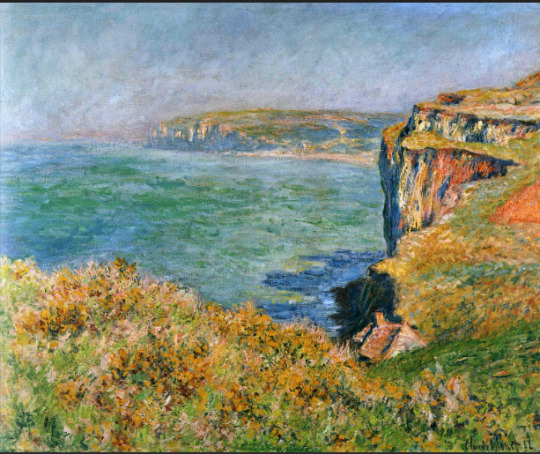

Some of my favourite nature paintings: Top: Ivan Aivazovksi's The Ninth Wave (personal favourite, I have a print of it!). Bottom left: Claude Monets' Cliff at Varengreville. Bottom right: Albert Bierstadts' Mount Corcoran.
The most important part of art and nature is the translation of sentiment from artist to audience (Beck et al., 2018). As I said above, I find that my favourite pieces make me feel anything. The ones I added to this post make me feel small, in a good way. Nature is everywhere, and it's boundless, so I appreciate each of these paintings for the way that they can capture that feeling, at least to me.
My kind of nature interpretation through art would probably be the art of flower pressing. My dad and I used to do it when I was young, and I remember pressing the first flowers that would bloom in our backyard in the springtime. I find pressing flowers creates a memory, and as someone who loves preserving things and being able to remember them later, pressing flowers was the way to do that. I also like that I was able to do it with my dad, and that he taught me the way to do it, so I can do it with someone else in the future.
In conclusion, the relationship between art and nature is quite the dramatic interplay, shaped the most by the interpretations of both the artists and the viewers.
References:
Beck, L., Cable, T. T., & Knudson, D. M. (2018). Interpreting cultural and natural heritage: For A Better World. SAGAMORE Publishing.
5 notes
·
View notes